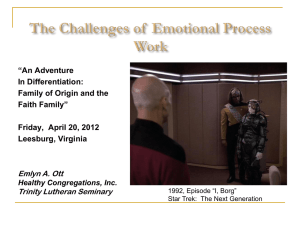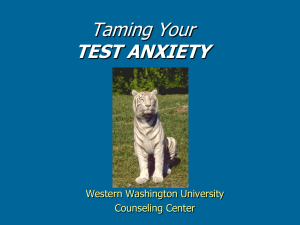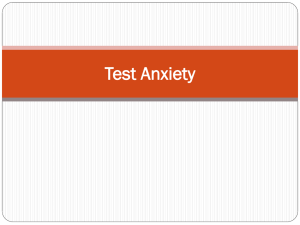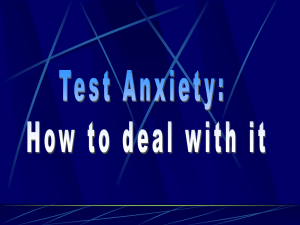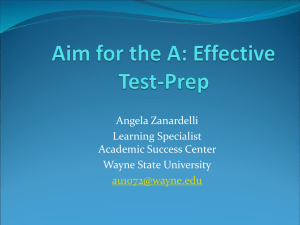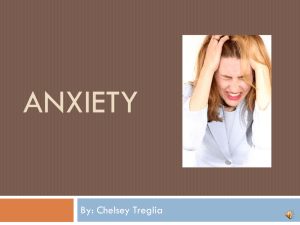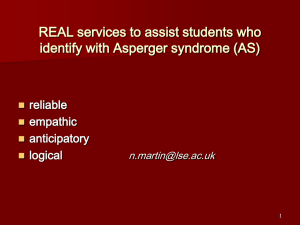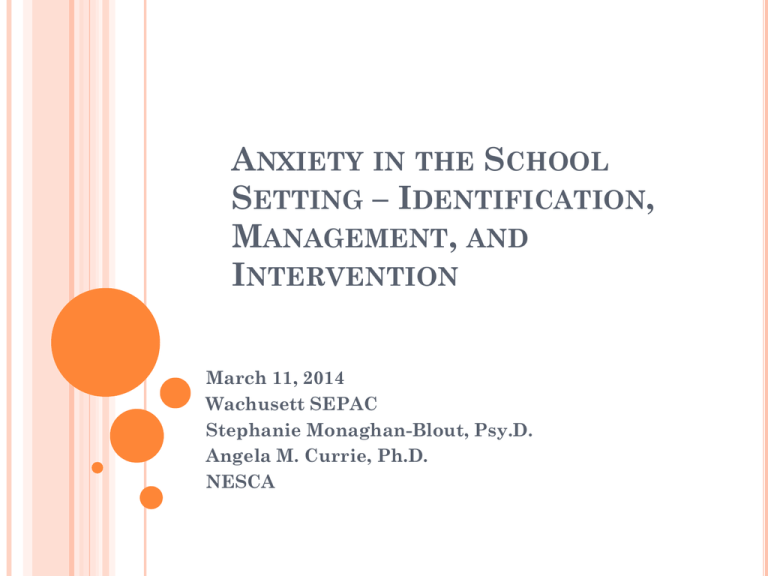
ANXIETY IN THE SCHOOL
SETTING – IDENTIFICATION,
MANAGEMENT, AND
INTERVENTION
March 11, 2014
Wachusett SEPAC
Stephanie Monaghan-Blout, Psy.D.
Angela M. Currie, Ph.D.
NESCA
UNSCIENTIFIC SURVEY
Neuropsychological Evaluations October, 2009October, 2012
N=143 (incomplete)
Age span 4 years -23 years
Sex Distribution is roughly equal
The vast majority of these students are in
elementary-middle-high school.
Diagnostic Distribution (N>10)
Diagnosis I
ADHD
Autism Spectrum Disorders
(including PDD and
Asperger’s)
Cognitive (Intellectual Disability)
PTSD, Developmental Trauma,
Reactive Attachment Disorder
Language-Based Learning
Disability
Anxiety
32
25
19
17
16
12
Diagnostic Distribution
Diagnosis II (N>10)
Anxiety
55
ADHD
20
Language based Learning
Disability
12
Diagnostic Distribution
Diagnosis III (N>10)
Anxiety
ADHD
20
12
ANXIETY OR ANXIETY?
Anxiety
Disorder
Anxiety is excessive/greater in intensity/of
longer duration than expected given the
context
Leads to Impairment/Disability/Avoidance
Includes Clinically Significant but Unexplained
Physical Symptoms or Compulsions
ANXIETY SECONDARY TO OTHER
PROBLEMS
Could
be medical difficulties such as Thyroid and
other Endocrine Abnormalities
Licit
(prescribed) and Illicit (recreational) drugs
Life
Circumstances which cause such as acute
and chronic stress
Problems
with Performance in Key Domains of
Functioning- i.e. school
PERFORMANCE ANXIETY
SECONDARY TO ATTENTION, LEARNING, AND
SOCIAL ISSUES.
FUNCTION OF ANXIETY
The
Body’s Alarm SystemEnable us to gear up to
respond to threat
LIMBIC SYSTEM- MORE THAN A FEELING
Old
Notions as the Emotional Brain are too
simplistic
Transitional area whose systems are interconnected
with more primitive regions as well as more
complex neocortical regions. Cannot “put your
finger” of the source of emotion- integrity of whole
system is necessary for normal functioning
Important for establishing and mediating links
between cognitive states, visceral states and
emotions
Focuses on the relevance and particular value of
objects, people, settings, and actions rather than
their identification and recollection per se
(Meshulam, 2000
MANY OF THE SYSTEMS/PROCESSES
IMPORTANT IN EMOTIONAL FUNCTION
ALSO PLAY A ROLE IN LEARNING AND
MEMORY
Hypothalamus
– controls the autonomic
nervous system (visceral states)
Hippocampus- converting information from
short to long term memory
Amygdala- conditioned fear response
Prefrontal cortex- attention and executive
function, including self-awareness
STRESS RESPONSE- THE
HYPOTHALAMIC-PITUITARY-ADRENAL
CIRCUIT (HPA)
As
the brain recognizes a threat, the
hypothalamus releases corticotropinreleasing hormone (CRH) which
stimulate the pituitary gland to release
Adrenocorticotropin (ACTH) which then
prompt the adrenal glands to release a
number of other hormones
IMPACT OF HORMONES
Switch
on systems needed to respond to threatsympathetic nervous system (Fight or Flight)
Switch off systems not essential to crisis response –
parasympathetic nervous system (Rest and Digest)included digestive system, reproductive hormones,
growth hormones
Stimulates the release of sugar (glucose) to power
muscles and brain to respond to the danger
(Cortisol)
Once danger is passed, Cortisol exerts a feedback
loop to shut the production of CRH by the
hypothalamus.
CHRONIC EXPOSURE TO STRESS WHAT IF
THE LOOP DOESN’T SHUT DOWN?
Significant,
ongoing stress in early childhood
can cause the HPA feedback loop to become
stronger, and with each reiteration, the loop
becomes stronger, leading to a very sensitive
stress response. Which this hypervigilance
may be adaptive in highly dangerous
environments, the “life or death” response to
minor irritants results in adjustment problems
in other settings
Chronic
elevations of the stress response can
have significant health consequences
Chronic
elevations of the stress response
interferes with learning
VARIABLE RESPONSE TO STRESS
Individual Variations- Genes and temperament
can contribute to under or over response to
threat. Example- shy children
Environmental Contributions- Exposure to
extreme and/or chronic stress during any part of
life cycle, including prenatally and in early
childhood before the brain is fully developed,
can alter the functioning of the stress response.
Example –traumatized children
LEARNED RESPONSE TO THREAT
ANXIOUS PEOPLE PAY MORE ATTENTION TO
THREATENING STIMULI
WHAT ARE THEY MISSING?
VICIOUS CYCLE
WITH REPEATED EXPOSURES TO
AVERSIVE STIMULI, THREAT ALERT
/RESPONSE BECOMES STRONGER AND
QUICKER,
REACHES ENDPOINT SOONER
AT SOME POINT BEGINS AND ENDS WITH
MEREST HINT
THE TOXIC TRIAD
Poor Problem
Solving
Anxiety
Inattention
RESPONSE
Fight
Flight
Freeze
FIGHT
Argumentative
Noncompliant
Oppositional
Impulsive
FLIGHT
Distractible
Gives
up quickly
Avoidant-
leaves the task,
classroom, school setting
FREEZE
Problems
with initiation
Problems
with shifting
Problems
with termination
IN THE CLASSROOM
“He just won’t try”
“She is more interested in the social scene than
in her work”
“If he just spent as much time working as he does
arguing….”
“I can’t help her if she doesn’t come to class”
“He just has to ask if he doesn’t know something”
EVALUATIONS
Many highly anxious children do not meet
criteria for DSM-IV Anxiety Disorders
Because current rating scales are not particularly
sensitive to performance anxiety, these measures
will not always pick up significant problems.
Identification of impact of anxiety usually comes
in more qualitative elements
QUALITATIVE ASSESSMENT OF ANXIETY
Behavioral Observations
Overt signs of anxiety
Changes in demeanor over time
Differences related to domain being assessed
Analysis of patterns of scores
Consistency/inconsistency
Abrupt changes, good or bad
Response to Intervention
Impact of validation
Effect of offer of modification
Change in persistence
SPELLING IT OUT- INTERACTION OF
ANXIETY
Really important to explicitly discuss how the
child’s anxiety interacts with other elements of
his/her profile
Attention
Learning
Social
Adaptive
TAKE HOME MESSAGE
1. ANXIETY INVOLVES THE THINKING BRAIN (ASSOCIATIONS AND
MEMORY) AS WELL AS PHYSICAL SENSATIONS AND EMOTIONAL
REACTIONS
(TOXIC TRIAD)
2. ANXIETY RESPONSES ARE LEARNED
3. THE BODY CAN BECOME HABITUATED TO ANXIETY (VICIOUS
CYCLE)
4.CONSTANT STATE OF STRESS/ANXIETY IS HARMFUL,
AFFECTING A WIDE RANGE OF OTHER SYSTEMS INCLUDING
LEARNING.
HOW DO YOU ADDRESS ANXIETY
AT SCHOOL AND HOME?
SOME THINGS TO KEEP IN MIND
Anxiety can present different across
environments/tasks
Changes over time
The “Whack-A-Mole Effect”
COORDINATION ACROSS ENVIRONMENTS
Consistency in skills
Optimize generalizability
KEYS TO DEVELOPING EFFECTIVE
STRATEGIES
Knowledge of learning profile
Sensitivity to temperamental style
Direct approach to stress response
Teach skills that are lacking – anxiety and nonanxiety
DIAGNOSTIC CONSIDERATIONS
Same behavior may have various root causes
Ex: School Refusal
GAD: overall worry about everyday activities and demands
Separation Anxiety: fear of leaving caregiver
Panic Disorder: fear of having a panic attack at school
PTSD: possibility of exposure to traumatic stimuli
Academic Anxiety: performance-based fears
Examine root cause of behavior to best inform
interventions
AGE CONSIDERATIONS
Cognitive techniques best for age 8+
Younger children require systemic and
behavioral approaches
Focus on self-advocacy and independence with
increasing age
GENERAL STRATEGIES
Listen to feelings
Model appropriate regulation
Reassure
Teach and encourage relaxation techniques
Plan ahead
Encourage leisure
Provide positive reinforcement
Involve the child
INEFFECTIVE STRATEGIES
Inaction
Dismissal of emotion
Punishment
Failure to generalize learning to problematic
situations (e.g. generic counseling)
WHAT CAN BE DONE AT SCHOOL?
Provide supportive environment
Reduce stressors as appropriate
Support skill acquisition
Support generalization of skills
PROVIDE SUPPORTIVE ENVIRONMENT
Check-ins – arrival, throughout day
“Safe place” or “break space”
Small group interactions
REDUCE STRESSORS
Adapt schedule
Late arrival
Modified day
Small lunch
Impose structure
Schedules
Previewing and warnings for transition
Assigning “tasks”
Alternate preferred and less-preferred tasks
Reduce workload
Adapt method of output/assessment
Separate for testing/extended time
SUPPORT SKILL ACQUISITION
Teach relaxation
Support peer interactions and perspective taking
Problem solving one-on-one
Illustrate “A-B-Cs” (antecedent-behaviorconsequences)
Provide positive self-talk “scripts”
SUPPORT GENERALIZATION
Provide prompts/reminders of skills
1:1
Visual cues
Take a “graded” approach to difficult tasks
COMMUNICATION
Encourage consistency across environments
In school and at home
BEHAVIORAL PLANS
Useful for clarifying
Goals
Triggers
Maladaptive responses and replacement strategies
Emphasize skill acquisition and application of
coping strategies
Illustrate specific de-escalation plan
Utilize positive reinforcement
BEHAVIORAL PLANS CONT.
Avoid plans that:
Do not adequately map the “A, B, Cs”
Do not identify the student’s strengths and current
skill sets
Do not teach skills
Do not include the child in their development
WHAT CAN BE DONE AT HOME?
Child-focused approaches
Family system-focused approach
REASON FOR INTEGRATED APPROACH
Faster acquisition of skills
Generalization of skills across contexts
Develop plan from multiple perspectives
Optimize Outcomes
Ex: When adolescents have co-morbid anxiety and
mood difficulties resulting in school refusal,
combination of CBT and medication most effective in
returning to school (Bernstein, et al. 2000)
INDIVIDUAL THERAPY
First line treatment
Cognitive Behavioral Therapy
Mindfulness and Acceptance Based Therapy
CBT FOR ANXIETY
Goals:
Psychoeducation about anxiety
Correction of distortions in thinking
Acquisition and application of relaxation techniques
Habituation to feared stimuli
Engagement in social relationships
Methods:
Exposure with response prevention
Homework
Structured, manualized approaches last approx. 12
weeks – not the norm
MINDFULNESS AND
APPROACHES
ACCEPTANCE BASED
Utilizes CBT strategies but with different approach
Mindfulness – increasing awareness of internal and
external experiences
Acceptance – promotion of willingness to be in the
present moment
MIND-BODY BASED THERAPY
Goals:
Increase understanding of anxiety
Open awareness of internal states
Practice and apply self-calming and self-regulatory
strategies
Increase patience and flexibility
Strategies:
Breath work
Movement
Visualization
INTENSIVE APPROACHES
Reasons for need:
Anxiety grossly interfering with academics/peer
interactions
School refusal
Learning disability interfering with acquisition of
skills
Benefits of more intensive treatment:
Increased frequency/opportunities for rehearsal
Quicker progress across shorter duration
Greater integration across contexts
PSYCHOPHARMACOLOGY
Work best in conjunction with therapy
Short or long term
Careful monitoring
FAMILY-BASED SERVICES
Parent guidance
Behavior management strategies
Consistency in expectations / schedule
Emotion coaching strategies
Family therapy
Identify and process sources of family-wide stress
Improve communication within the family
THINGS PARENTS CAN DO
Encourage exercise and healthy eating
Model appropriate self-regulation
“Do as I say, not as I do” does not work!!
Reduce chaos in child’s schedule
Have good follow-through
Consistency, consistency, consistency
THANK YOU!
QUESTIONS???



